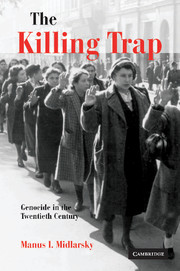Book contents
- Frontmatter
- Contents
- Preface
- PART I Introduction
- PART II Explaining perpetrators: theoretical foundations
- PART III The theory applied
- PART IV Victim vulnerability: explaining magnitude and manner of dying
- PART V Exceptions
- 15 A dog of a different nature: the Cambodian politicide
- 16 Dogs that didn't bark I: realpolitik and the absence of loss
- 17 Dogs that didn't bark II: affinity and vulnerability reduction
- PART VI Conclusion
- References
- Index
15 - A dog of a different nature: the Cambodian politicide
Published online by Cambridge University Press: 22 September 2009
- Frontmatter
- Contents
- Preface
- PART I Introduction
- PART II Explaining perpetrators: theoretical foundations
- PART III The theory applied
- PART IV Victim vulnerability: explaining magnitude and manner of dying
- PART V Exceptions
- 15 A dog of a different nature: the Cambodian politicide
- 16 Dogs that didn't bark I: realpolitik and the absence of loss
- 17 Dogs that didn't bark II: affinity and vulnerability reduction
- PART VI Conclusion
- References
- Index
Summary
Exceptions to the patterns identified thus far are now considered. First, the Cambodian politicide is contrasted with the genocides of Jews, Armenians, and Tutsi. This is a matter of some importance because of the frequent claim that the Cambodian mass murders between 1975 and 1979 amounted to genocide. The overall pattern in this instance, however, does not conform to that identified in the genocides analyzed in previous chapters.
The succeeding two chapters present cases where genocide was not committed even where it might have been expected to occur. In the first of the two chapters, I examine Bulgaria and Finland as exceptions to the pattern established in collaborating and perpetrating states in the Nazi orbit (Italy, Vichy France, and Romania). Territorial expansion prior to the Holocaust characterized the former two countries, whereas the three perpetrating states experienced territorial contraction. And in the last chapter of this part, a major deterrent to genocide, the ethnoreligious or ideological affinity to the victims on the part of powerful populations or governments, is suggested. Again, genocide did not take place where it might have been expected to occur.
Turning to Cambodia, the mass killings in that country during Pol Pot's murderous regime are often categorized with other seemingly identical instances. Cambodia and Rwanda, for example, are typically treated as genocides that differ little from each other in essential characteristics. However, the victimization rates for the two countries are similar only when treated as proportions of the total country population systematically murdered.
- Type
- Chapter
- Information
- The Killing TrapGenocide in the Twentieth Century, pp. 309 - 324Publisher: Cambridge University PressPrint publication year: 2005



